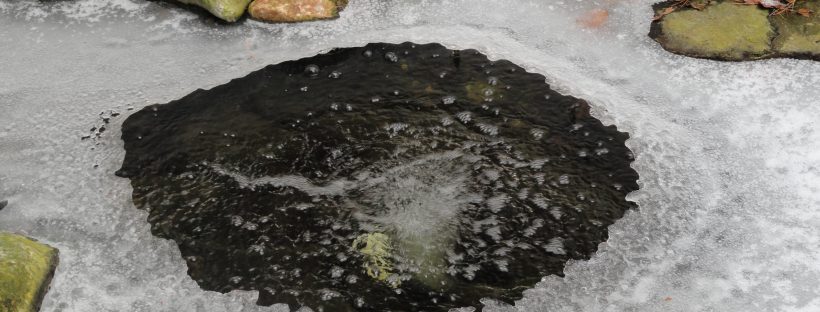Seasonal Tip – How how to install an aerator AFTER the pond ices over.

Winter presents a number of challenges in the water garden. Ice dams may divert water out of the stream. Ice drops the water level in the pond. The cold itself puts major stress on fish and plants, not to mention people. But the single most damaging effect of the cold happens when ice seals the pond off from the atmosphere.
When oxygen cannot diffuse into pond water, fish and the other animals in the pond will suffocate. Possibly even worse, toxic gases, such as methane and carbon dioxide, will build up and poison everything in the water. Luckily the solution is simple. Any hole in the ice will allow for gas exchange in both directions, keeping the pond and its inhabitants healthy over the winter.
It’s pretty well accepted these days by contractors and pond owners alike that aeration is the simplest, most effective and least costly way to keep a hole free of ice. Set at the edge of the pond in shallow water, the circulation caused by rising bubbles will maintain a small hole in the ice without cooling the water unnecessarily. But what happens if you forget to put a diffuser in before the pond ices over?
The last thing you want to do is smash a hole in the ice with a hammer! The shock waves in the closed system will transmit the shockwaves directly into the fish, stunning and perhaps even killing them. One less forceful and less damaging way of opening a hole in ice for gas exchange is to use hot water. You can pour hot tap water directly onto the ice.

For larger diffusers or thick ice use a pot or kettle with a diameter at least as large as the diffuser. Fill it with water and bring it to a boil, then set it on the ice near the edge of the pond. For very thick ice you may have to repeat the process. Once the hole is open and the diffuser set, you can relax for the rest of the winter, knowing your fish will be safe!
About the Author:

DEMI FORTUNA
Demi has been in water garden construction since 1986. As Atlantic’s Director of Product Information, if he’s not building water features, he’s writing or talking about them. If you have a design or construction question, he’s the one to ask.


